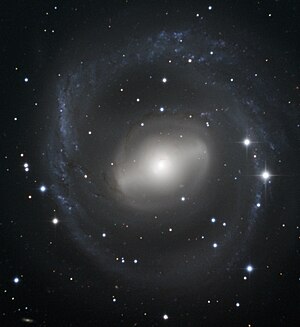NGC 2217
| Galaxy NGC 2217 |
|
|---|---|

|
|
| Recording with the 3.6-m telescope of the ESO in the La Silla Observatory | |
| AladinLite | |
| Constellation | Big dog |
|
Position equinox : J2000.0 , epoch : J2000.0 |
|
| Right ascension | 06 h 21 m 39.8 s |
| declination | −27 ° 14 ′ 02 ″ |
| Appearance | |
| Morphological type | (R) SB (rs) 0 / a / LINER? |
| Brightness (visual) | 10.7 mag |
| Brightness (B-band) | 11.6 mag |
| Angular expansion | 4.7 ′ × 4.3 ′ |
| Position angle | 21 ° |
| Surface brightness | 13.8 mag / arcmin² |
| Physical data | |
| Affiliation | LGG 136 |
| Redshift | 0.005400 ± 0.000017 |
| Radial velocity | (1619 ± 5) km / s |
|
Stroke distance v rad / H 0 |
(64 ± 5) · 10 6 ly (19.6 ± 1.4) Mpc |
| diameter | 100,000 ly |
| history | |
| discovery | John Herschel |
| Discovery date | January 20, 1835 |
| Catalog names | |
| NGC 2217 • PGC 18883 • ESO 489-G042 • MCG -05-15-010 • IRAS 06196-2712 • 2MASX 06213977-2714014 • GC 1401 • h 3041 • AM 0619-271 • LDCE 0435 NED003 | |
NGC 2217 is a lenticular galaxy of the Hubble type SB0-a in the constellation Great Dog south of the celestial equator . It is around 64 million light years away from the Milky Way and has a diameter of around 100,000 light years.
The object was discovered on January 20, 1835 by the British astronomer John Herschel .
NGC 2217 group ( LGG 136 )
| Galaxy | Alternative name | Distance / million Lj |
|---|---|---|
| NGC 2217 | PGC 18883 | 64 |
| PGC 18765 | ESO 489-029 | 68 |
| PGC 18886 | ESO 426-001 | 72 |
Web links
- astronews.com: Picture of the day January 23, 2012
- SIMBAD Astronomical Database
